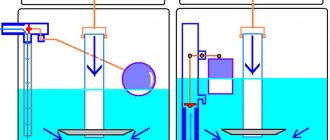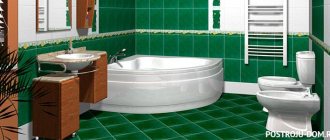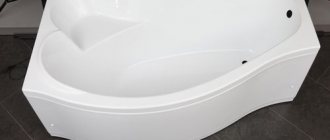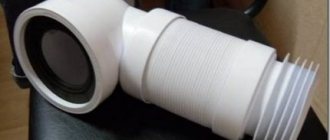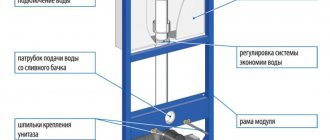The condensation that appears on the toilet cistern puzzles many owners of comfortable housing. Due to droplets of water constantly flowing from the surface of the cistern, puddles form on the floor, which must be wiped off in a timely manner. Otherwise, dampness will lead to mold and an unpleasant odor. Of course, you can adapt some kind of container to collect water, and then remember to empty it of its contents in a timely manner. Many housewives do this, trying to solve this problem in this simple way. Men are trying to find out why the toilet tank is sweating, so that by eliminating the cause, they can forget about the problem forever. Are there effective ways to deal with condensation that periodically appears on the toilet tank? Let's figure it out.
Reasons for the formation of condensation on the drain tank:
- High level of humidity in the bathroom and throughout the entire apartment. Increased humidity can be caused by a large number of indoor plants, drying a large amount of wet laundry, leaking water pipes or heating systems, and other factors.
- Continuous flow of cold water into the toilet tank for even a second due to a malfunction of the shut-off valves, as a result of which the water does not have time to warm up to room temperature.
To understand why the toilet tank sweats, you need to remember a little about your school physics course. The contact of warm and moisture-saturated air with cold surfaces inevitably leads to the appearance of water droplets on them. This means that we need to look for ways to dry the air, as well as increase the temperature of the surface of the drain tank.
Causes of condensation
If drops of water are constantly forming on the tank of your toilet, the first thing you need to do is identify the cause of their appearance.
A common cause of condensation in the toilet is high humidity in the room. To normalize this indicator, it is necessary to identify the cause of the increase in humidity.
Dry indoor air has a negative effect on human health, but high humidity also leads to bad consequences. This may cause fogging of the tank, walls and floor.
Increased humidity in the bathroom can be caused by various reasons:
- The apartment or house contains a large aquarium or a lot of vegetation that requires constant watering. In these cases, the problem can be solved by installing dehumidifiers.
- Washing and drying clothes is carried out in significant volumes, which is more often observed in large families. It is recommended to hang washed laundry on the balcony or in the yard.
- Moisture can settle on the cistern and bathroom wall surfaces due to leaking sewer pipes or connections. It is urgent to identify and fix the plumbing problem.
- Insufficient ventilation does not fulfill its functions, as a result of which the room cannot dry quickly.
- Due to a breakdown of the shut-off valves, cold water may constantly flow in the tank, which does not have time to reach room temperature and causes condensation to appear on the walls of the plumbing.
Condensation forms on the tank of plumbing equipment due to the fact that the air temperature in the room differs from the temperature of the water in the toilet by about 15 degrees. Therefore, the outer surface of the tank begins to fog up.
Since water enters the toilet from a water supply system located underground or outdoors, its temperature depends on external weather conditions.
In winter, the heating season begins, during which the room heats up. During this period, the greatest difference in temperature between the air in the bathroom and the water in the toilet is observed.
The laws of physics will help identify the original source of the malfunction. As you know, warm air currents, in contact with cold water (in the drain tank), are converted into droplets of moisture. The process of condensation formation on the tank can be stopped by studying in more detail the possible causes of this phenomenon and ways to eliminate them.
Leveling the temperature balance
To achieve approximately the same water temperature in the tank and in the room, there are two ways.
- Decrease in air temperature
The problem usually occurs in winter, so the first method is not always practical. You can achieve the result by lowering the overall temperature in the system, but then the house will become several degrees cooler. This also has its advantages, because you can save on heating.
A decrease in air temperature helps to equalize the temperature balance
With a centralized system, this cannot be solved. You should take care of the thermal insulation of pipes near the bathroom, and also ensure that the doors to the room are closed.
The consequences of condensation on the drain tank
If you do not take immediate action when water droplets appear on the toilet cistern, then a puddle with an unpleasant odor will appear under the plumbing equipment.
In the future this will lead to the following consequences:
- increasing humidity in the bathroom;
- the occurrence of mold and fungi;
- the appearance of an unpleasant damp smell;
- plumbing will be subject to corrosion, causing it to rust and lose its attractive appearance;
- formation of rust and corrosion, gradual destruction of the sewer pipeline;
- the tank and its bolts will begin to rust, become unusable and require replacement;
- rotting of floor and ceiling materials, which can cause partial destruction of the ceilings.
The problem of condensation in the bathroom, at first glance, may seem insignificant, but if this phenomenon is ignored for a long time, serious consequences can occur.
Dampness, black mold, unpleasant odor, discomfort and complaints from neighbors living below about the appearance of stains on the ceiling are the results of continuous condensation on the surface of your toilet cistern.
Due to constant condensation in the bathroom, pipes corrode and rust, which subsequently leads to their destruction and leakage
In addition to pipe corrosion, there is a more serious problem. If you ignore the formation of puddles on the floor for a long time, then under the influence of moisture a gradual process of rotting of the floor materials occurs.
As a result, water seeps below, provoking processes of rotting of materials on the ceiling of neighbors living below. At first, damp stains will appear on the ceiling. In the future, the destruction of the ceiling between apartments is possible.
If your toilet cistern is sweating, you need to take drastic measures immediately. Methods for dealing with unaesthetic condensation depend on the reasons for its formation.
Image gallery
Photo from
Negative effects on coating and recoating
Black mold on the bathroom floor
Damp walls in the toilet
Metal plumbing parts and fittings
General information
To understand how to deal with condensation, you need to understand the essence of the phenomenon and why it forms.
Condensation is water particles that settle on a surface from the air. Moisture forms because there is a sudden change in temperature.
The formation of condensation on the drain tank can be explained by the fact that inside the drain tank there is cold liquid, which does not have time to heat up from the warm external air. The outer walls of the tank are exposed to a sharp temperature difference, so water droplets form on it.
Condensation on the tank indicates that there is some problem with the operation of the device. It must be identified and then eliminated.
If you constantly drain water from the tank and fill it, then the cold water, not having time to warm up to the temperature in the room, forms condensation. The formation of condensation is also facilitated by impaired ventilation. If the door to the room closes tightly and there is a high threshold at the entrance, and the ventilation hole is located far from the toilet.
This state of ventilation in combined bathtub and toilet rooms is considered the most dangerous; there is a risk of suffocation.
The third main reason for the accumulation of condensation on the tank is considered to be a malfunction of the internal fittings. Leaking gaskets or failure of the float mechanism lead to a high consumption of cold water, so excess moisture forms on the outside of the tank.
Excessive humidity in the toilet can appear when humid air from other rooms in the apartment enters the bathroom.
Or, if the house drys clothes in a combined bathroom or in the kitchen located next to the toilet.
Having identified the cause of the appearance of moisture on the tank, you can begin to eliminate it; when the problem is solved, the formation of condensation will end.
The formation of condensation on the tank does not always require replacing the tank mechanisms or repairing the ventilation.
For example, the drainage container fogs up only when the bathroom or bathtub is actively used. If the tank dries out between uses of the plumbing fixtures, then you should not use radical methods of dealing with moisture.
If condensation flows onto the floor, forming a puddle, then it’s time to identify the cause and fix the problem.
Attention! It is impossible to use a mirror with mold; you will have to buy a new one.
Condensation spoils the microclimate of the bathroom, which leads to damage to the plumbing and furniture in the room. In a maximum of five years, a complete renovation of the toilet or combined room will be required.
Excessive water consumption in the bathroom
Sometimes the toilet tank fogs up due to excessive water consumption. In bathrooms where the toilet is flushed frequently, more cold liquid enters the tank, which increases the likelihood of condensation forming.
To solve this problem, you need to adjust the fittings, reducing the amount of water supplied to the tank. In a large family, the toilet is used frequently, so it is better to buy a toilet with an adjustable or stepped flush.
Purchasing plumbing equipment with an adjustable drain will reduce fluid consumption, save money and save the tank from condensation.
Minimizing flushing can be done using toilets equipped with a cistern with a two-button flush mechanism. If one button is used, 5 liters of water flows out of the cistern, and if the other button is used, approximately 7 liters.
Some models have tanks with aquastop drain. The lid has one control button: the first time you press it, the water begins to drain, and the second time this process stops.
Results
It is possible to equip the system with a heat exchanger if the riser is located near the pipe that supplies water to the drain tank. The heating riser is wrapped around a copper tube 5 times, then it is inserted into a flexible liquid line into the tank. The coil is wrapped with mineral wool for insulation purposes.
To make a half flush system, you need to adjust the fittings inside the tank. In this situation, it is better to use a flushing device with a double button, which flushes normally or halfway.
Insufficient toilet ventilation
Sometimes installing a ventilation device or an additional fresh air supply is enough to say goodbye to the problem forever.
How to check the ventilation system?
If your toilet cistern is sweating, you urgently need to check the integrity and serviceability of the ventilation system in the bathroom. You need to bring paper, a candle or a lighter to the ventilation grille.
The system works fine as long as the paper sticks and the flame burns evenly. If paper falls or the flame goes out, then urgent measures must be taken to restore ventilation.
The process of diagnosing the operation of ventilation can be carried out independently by the home owner in a simple but effective way using improvised means.
You can solve the problem of constant condensation in the following ways:
- Cleaning ventilation ducts.
- Installing an additional fan on the exhaust duct.
An effective option for getting rid of exhaust air and obtaining a clean influx is to leave a gap 2 cm high.
An excellent solution is to install a multifunctional door valve that allows air from outside and at the same time blocks unpleasant odors, preventing them from spreading throughout the living space.
Any room with high humidity (toilet, kitchen, bathroom) has ventilation windows that ensure optimal air circulation in the room
A malfunctioning ventilation system may cause the tank to sweat. But most owners of living space, trying to make the room look better, simply cover the ventilation holes with finishing. There is no need to do this; a good option is to buy beautiful decorative grilles designed specifically for this purpose.
Installing a fan in the bathroom
In order to stop the process of fogging of the tank, walls and floor in the bathroom, try installing forced ventilation in the room.
Sometimes a simple fan, which is mounted in the vent and starts to function when the light in the toilet is turned on, can eliminate the formation of condensation on surfaces. If this does not solve the problem, you should call specialists to install more effective ventilation systems.
You can improve the quality and circulation of air flow in the bathroom by installing additional modules in the room - fans and hoods
If the toilet cistern is sweating, you should first check the ventilation. Some owners, in order to “cultivate” the bathroom, completely seal up the existing ventilation holes.
Consumers should pay attention to the decorative grille, which will save you from problems with ventilation and will look aesthetically pleasing. One way to solve the problem is to leave the door to the toilet ajar.
The most effective way to combat condensation is to install a professional ventilation system that maintains an optimal level of humidity in the room
Installation of forced ventilation is often used in combined bathrooms, which are characterized by the appearance of condensation on the toilet, tiles, ceiling, mirrors and other surfaces. In this case, it is better to install a professional ventilation system.
The power of the equipment must correspond to the operating conditions, then droplets of condensation will stop appearing.
Installation of an axial fan in the exhaust hole located in the bathroom is carried out in the following order:
Image gallery
Photo from
Step 1: Prepare the exhaust vent for fan installation
Step 2: Marking the fan mounting points on the wall
Step 3: Connecting the Fan Wires to the Wiring
Step 4: Attaching the external axial fan panel
To check whether the ventilation in a plumbing unit is working properly, you need to do a second check: light a lighter (candle, match), bring it to the hole and look at the light.
If it goes out or is drawn into the ventilation duct, then the ventilation system is functioning well. If the position of the flame remains the same or the deviation is small, you need to consider another method.
Checking the condition of the ventilation holes
To reduce the level of air humidity, you need to adjust the ventilation of the bathroom. Each apartment has special ventilation “windows” that provide air circulation. In pursuit of the beauty of the interior, some residents seal these holes with finishing materials, which, of course, is unacceptable.
To disguise ventilation windows, you need to buy decorative grilles that are specifically designed for this purpose. They can be selected by color, shape, and design. Before installing decorative grilles, clear the ventilation ducts of debris.
Installing a fan that turns on when the lights are turned on will help partially solve the problem of condensation.
Air ventilation in the room can be organized even more efficiently if you connect a forced ventilation system. To calculate the power of the ventilation system, you must contact specialists. After assessing the condition of the bathroom and the intensity of its use, professionals will give recommendations on the choice of equipment.
Ways to deal with condensation
The reasons for excessive moisture on the toilet cistern were described a little higher. Now let's look at the simplest ways to eliminate them.
If condensation on the walls of the flush tank occurs only in the summer, take the following measures:
Image gallery
Photo from
Step 1: Using Tank Cover
Step 2: Increase room ventilation
Step 3: Reducing the temperature inside the bathroom
Step 4: Installing the Mixing Valve
Method #1. Repair of shut-off valves
A common cause of the formation of wet condensation on the outer surface of the tank is the breakdown of shut-off valves and float mechanisms. Due to a faulty mechanism, cold water from the sewer pipes flows continuously into the tank without having time to settle.
As a result of the movement of cold water flows, condensation appears. If there is a meter, the owner of the apartment will have to pay for the leakage.
If your plumbing drain tank is broken, it will constantly leak water. Because of this, the surface of the tank will be colder than the air in the room, so it will fog up.
Most modern plumbing models do not require “local” repairs, so manufacturers do not produce small spare parts for them. In the event of a breakdown, you will have to purchase a set of shut-off valves.
If you can identify faulty structural elements and make repairs at the site of the breakdown, you will be able to reduce excessive cold water consumption, which is important for housing with a meter.
You can solve the problem without plumbing skills with the help of a specialist. If you are familiar with the principle of operation of the drainage system, then you can carry out the repair yourself, while saving on calling specialists.
Depending on the toilet model, there are two ways to solve the problem - replacing the shut-off valves or local repairs of failed structural parts.
Method #2. Repairing water leaks
Condensation can appear due to various factors, one of which is water leakage. More often, the breakdown is caused by malfunctions of parts of the fittings and is observed when filling the container with cold water.
Condensation forms at any water pressure, but the degree of fogging of the tank depends on the power of the pressure. To fix the problem, you need to adjust the water drainage system or replace faulty parts.
Due to water leakage, the air in the bathroom becomes more humid, puddles may appear around the toilet and an unpleasant odor may appear.
If water flows freely into the toilet in a thin stream, its volume in the flush tank must be constantly replenished. This explains the appearance of condensation on the surface of the tank, walls and floor, as well as high water consumption.
In some cases, replacing the worn rubber siphon membrane will solve the problem. The replacement process goes like this:
- All water is drained from the tank;
- the lever is fixed in such a position that the drain hole is closed with a valve and water does not flow into the device;
- the siphon is disassembled by separating the part from the lever;
- take out the worn out membrane and replace it with a new one.
At the end, the siphon is put in place and a test drain is made.
When purchasing a new rubber membrane, you must take into account that the dimensions and material of the part must ideally match the design of your toilet.
If the cause of the toilet leak is a faulty float, you must do the following:
- remove the float from the drain tank;
- pour the water out of it and let it dry;
- glue the hole through which water flows;
- install the float in place.
The best option is to buy a new float, since a repaired part will not last long. The problem can be easily solved if the water leakage is due to an incorrect placement of the float.
To fix the problem, you need to open the toilet tank and set the lever to its normal operating position.
Method #3. Installing a double wall cistern
Manufacturers of plumbing equipment have developed innovative toilet models equipped with a cistern with a double-wall system. The design of the toilet is distinguished by the presence of double walls in the tank for draining water.
In this case, the additional plastic container located inside does not come into contact with the walls of the main ceramic bowl, forming an air cushion. As a result, the water has a constant room temperature.
On the plumbing market you can find toilet models with an improved flush tank design that eliminates the formation of condensation. Double-walled flush tanks never sweat
A new design solution from plumbing developers makes it easy to solve the problem of fogging in the toilet tank. For most buyers, these models are unaffordable - they are several times higher than the cost of standard toilets. Therefore, some home craftsmen independently make double walls in the drain tank.
It is better to treat the inner walls of the bowl with liquid waterproofing materials, for example, mastic. Bonded materials are less effective and durable.
Method #4. Thermal insulation of the cistern
You can insulate the walls of the drain tank from the action of cold water using heat-insulating materials that are firmly glued inside the tank.
In the process of installing thermal insulation on a tank or pipes, special insulating materials and improvised means are used. Neoprene or expanded polystyrene foam is often used as insulation.
Some homeowners independently struggle with the problem of fogging of the plumbing fixture tank by pasting the inner walls of the container with heat-insulating material
Thermal insulation prevents the walls of the drainage device from coming into contact with cold water.
To obtain the required result, you must perform a number of actions:
- Turn off the water supply to the plumbing fixture.
- Disconnect the hose that supplies water to the drainage system.
- Remove the water drain tank.
- Disassemble all the elements located in the middle of the drain bowl.
- Wash and dry the container.
- Cut out the liner from the heat-insulating material (spread it on a flat surface, place the tank on it, circle the bottom along the perimeter and cut off the workpiece).
- Place the resulting workpiece inside the container and press tightly.
- Measure the internal height of the walls (from the liner to the top edge of the tank).
- Measure the perimeter of the walls, adding an allowance of 100 mm.
- Place the pattern in the middle of the container. Since the joint will overlap, you need to press the workpiece against the wall and make a through cut.
- Get the blanks for further assembly.
- Apply sealant to the bottom near the holes for the fittings.
- Put the bottom in its place.
- Apply glue to the sides of the container, then place the inner liner.
- Use silicone to fill the vertical joint.
- Seal the joint between the walls and the bottom with sealant.
- After 24 hours, you can make holes for the reinforcement and apply sealant to the edges.
- Install all elements in place.
It should be borne in mind that thermal insulation of the toilet cistern is not always able to solve the problem of fogging of the plumbing fixture
How to properly fix a leak between the tank and the toilet
If a leak appears between the tank and the toilet, then the reason is the depressurization of the device. Most likely, the problem is in the deformation of the seal, a special rubber gasket. To fix the problem, you will need to replace the gasket.
Gasket replacement steps:
- First, turn off the water supply;
- The liquid from the tank will need to be drained, possible residues will also be removed;
- There is a drain nut under the descent hatch that should be loosened;
- Then you should remove the tank by unscrewing the corresponding nuts at the fastening point;
- You will also need to unscrew the drain;
- Next you need to replace the gasket;
- Then reinstall all parts back into place.
But the cause of the problem may also be an old rusty bolt that holds the container to the bowl. Next you will need to replace the damaged part. Also, first the water is shut off and the water is drained. The bolts will need to be removed and replaced with new ones. Sealing washers are required.
When purchasing gaskets, be sure to take into account their size, because the element is available in different forms. That is why you need to know exactly the dimensions of the part.
Sometimes you can only tighten loose bolts. To do this, just fix the element with a key and turn it with a screwdriver. But you need to be careful not to damage the ceramic bowl. That is why it is better to replace parts rather than constantly tighten them.
Other ways to deal with condensation
Another solution to the current problem of high humidity in the bathroom is to purchase a dehumidifier.
The principle of operation of the electrical appliance: a powerful fan directs a flow of moist air into a special cooling chamber, in which the process of condensation of moisture occurs and its separation into a special container. Then the dried air is heated and successfully returned to the bathroom.
If forced ventilation installed in the bathroom cannot cope with excess humidity, you can use a compact portable dehumidifier
In addition to the above methods of combating the formation of condensation on the tank and other surfaces, experts suggest considering the possibility of installing heated towel rails.
Another simple but effective method of eliminating the process of moisture formation in the bathroom is to increase the temperature of the water that constantly enters the home toilet system.
To begin with, it is recommended to try to properly insulate the sewer pipes. If this technique does not help, then you can install a special boiler designed to heat the water in the drain tank to room temperature.
If you are unable to identify why the toilet tank is constantly sweating and remove the condensation yourself, you need to contact professional plumbers.
Normalization of air circulation
First of all, check how effectively natural ventilation works. Ventilation windows should be covered with bars and under no circumstances clogged with dirt and dust.
Natural ventilation is the key to protection against high humidity and mold
Many users prefer to leave the bathroom door open, but a better option is to make a gap at the bottom.
To improve air circulation, you should install a ventilation grill in the bathroom door
Before installing decorative mesh, the channel should be cleared of debris; if this has not been done, then there is a possibility that there is no draft in the system. In this case, it needs to be cleaned. In a private house, this responsibility falls directly on the owner, in multi-storey residential buildings - on the housing office, where you should contact.
Natural ventilation is not always ensured by ventilation. In this case, an artificial one should be installed. It is difficult to do this on your own, since you need to take into account the power of the equipment and the state of the microclimate of the room, so we recommend contacting special centers.
If natural ventilation is of poor quality, it is necessary to organize forced ventilation
There are also systems that dry air, which are aimed at shared bathrooms. They provide a reduction in humidity by recycling water vapor.



